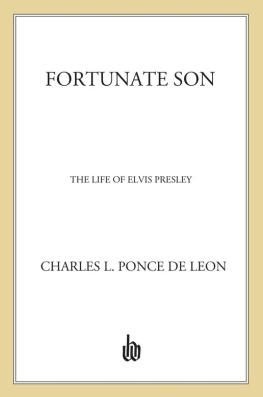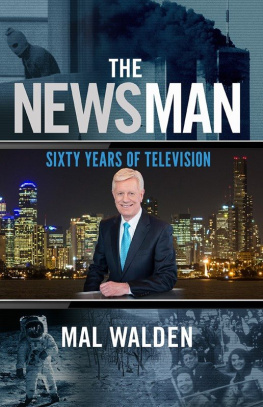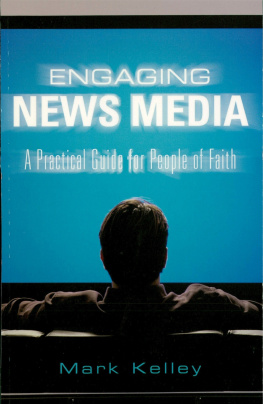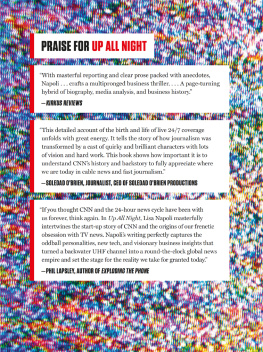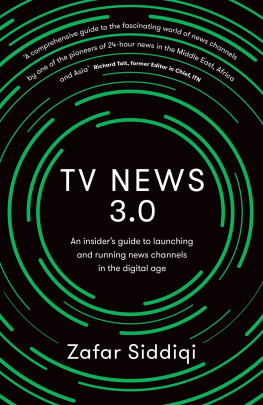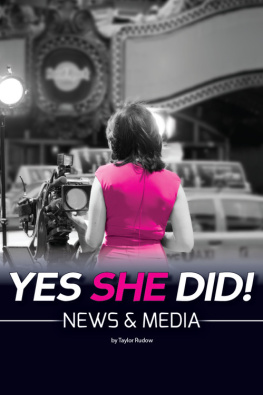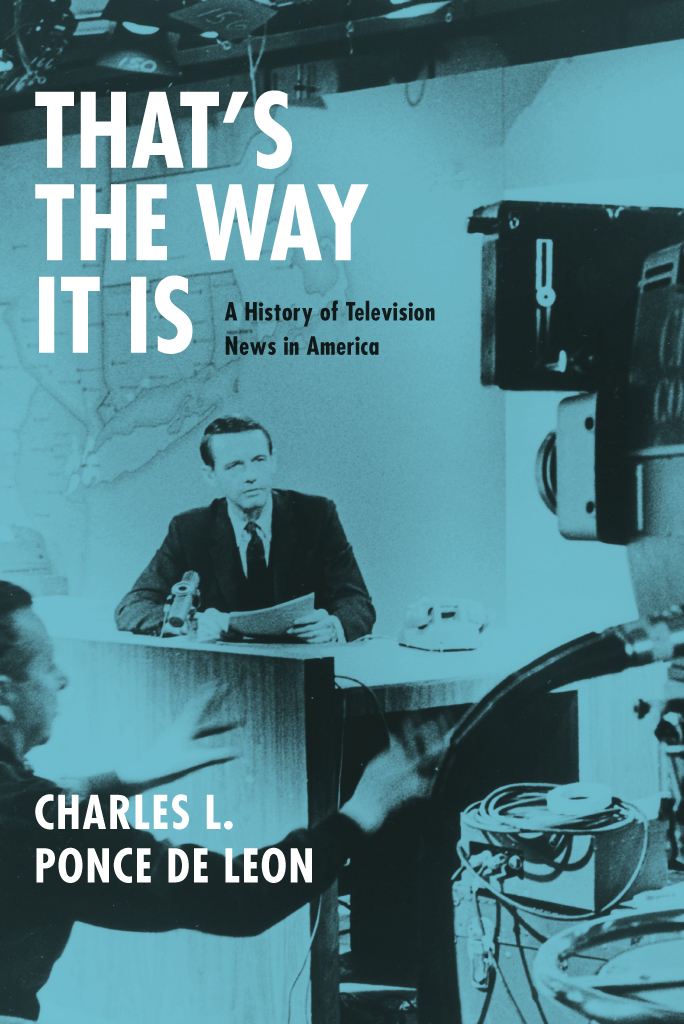Charles L. Ponce de Leon
All rights reserved. Published 2015.
Ponce de Leon, Charles L. (Charles Leonard), author.
Thats the way it is : a history of television news in America / Charles L. Ponce de Leon.
Includes bibliographical references and index.
ISBN 978-0-226-47245-4 (cloth : alk. paper) ISBN 0-226-47245-0 (cloth : alk. paper) ISBN 978-0-226-25609-2 (e-book) 1. Television broadcasting of newsUnited StatesHistory. 2. Television broadcasting of newsSocial aspectsUnited States. I. Title.
HE 8700.8. P 2015
This paper meets the requirements of ANSI / NISO Z39.481992 (Permanence of Paper).
Like many people my age, I grew up with television news. My parents watched it every night at dinnertime, and I remember well the luminous glow of our black-and-white screen and the grim visages of the anchormen we welcomed into our home. My father liked The Huntley-Brinkley Report on NBC, and was especially fond of Chet Huntley. My mother cheerfully submitted to his viewing preferencesthough when he began to travel more frequently for business, she switched to TheCBSEvening News with Walter Cronkite. After Huntleys retirement in 1970, my father watched CBS, too.
Its Cronkites program that I recall most vividly. It was in the late 1960s that I began to watch the news rather than merely notice it in the background as I played with toys or daydreamed at the dinner table. And it was TheCBSEvening News that helped to shatter the illusion that I lived in a cloistered, idyllic world. Cronkite and his intrepid correspondents made me aware of Vietnam, of the civil rights and anti-war movements, and of new social and cultural trends that, to a child, seemed bewildering. They told me about the crime and violence that were sweeping the nation, and were often on hand to describe and explain riveting events like the assassinations of Martin Luther King Jr. and Robert F. Kennedy and the mayhem that occurred at the Democratic National Convention in August 1968. I remember the RFK shooting particularly well. My mother was very fond of him, and she allowed me to stay up late to watch the election returns and see him declare victory in our home states primary. So I was awake and watching when, shortly after his victory speech, we were told he had been shotand even got a quick glimpse of him lying, fatally wounded, on the Ambassador Hotels kitchen floor.
I remember television providing us with good news, too, including the momentous Apollo 11 moon landing. Our family had closely followed the progress of the American space program, and its success in putting a man on the moon was truly awe-inspiringdespite our having to wait for what seemed like an eternity while the TV displayed the same unchanging image and Cronkite and his associates struggled to fill the hours with information and commentary. But it seemed to bring us mostly bad news, and by the early 1970s we tuned in with a sense of trepidation, as the political and cultural upheavals of the era were soon accompanied by economic problems and evidence that the era of postwar prosperity was over.
By the mid-1970s I not only watched the evening news every night but also read our local newspaperand, on many days, the San Francisco Chronicle, which I delivered as a paperboy. I avidly followed the Watergate scandal and the revelations unearthed by the many congressional hearings that were held in the wake of the Vietnam War. The more I learned, the more I came to perceive a blurring between the once distant public world covered by journalists and my own adolescent private world. As we waited in line for gas, drove by the squalid urban ghettos of San Francisco or Oakland, or encountered the increasing number of disaffected young people whose contempt for the postwar American Way of Life was readily evident in their appearance and rebellious posturing, I began to see myself, my friends, and my family as participants in the grand drama of our national life, a drama conveyed so evocatively by journalists. Somehow or another, everything seemed connectedthough, at the time, I scarcely understood how and, distracted by adolescence, made few efforts to figure it out.
Gradually, however, I stopped watching television news. In my first couple of years in college, I even stopped reading newspapers. I would watch Walter Cronkiteand then Dan Ratherwhen I was home and my parents did. But the rhythms of college life and postcollegiate young adulthood werent compatible with my old news habit. When I began my graduate studies in the mid-1980s, I would sometimes tune into the CBSEvening News, but I found it less satisfying, and I soon embraced a jaundiced view of TV news that reflected my professional aspirations as a PhD student and budding academicthat television news was bland and insipid and a poor substitute for the more substantive intellectual nourishment provided by prestige newspapers and magazines. Accordingly, when I resumed following the news in the late 1980s, it was by becoming a regular reader of the New York Times.
I still watched TV news from time to time. My wife and I especially enjoyed 60 Minutes, and we turned on Dan Rather or Peter Jennings when something big occurredlike the fall of the Berlin Wallor for election coverage. If a story was particularly big, we would tune in for several days, sometimes even weeks, to follow it to its conclusion. In the early 1990s, when we finally got cable, we also started watching CNN. Yet when I watched TV news, even CNN, I couldnt help but notice that it had changed since the days when I had been an avid viewer. The changes became especially apparent in the mid-1990s, when the networks and CNN feasted on the O. J. Simpson case. It got to the point where I could hardly watch at all.
There was a ready explanation for what had happened. I first encountered it in the late 1980s in articles about the television industry that I read in the Times, and it gained wider currency when several retired television journalists, including Cronkite, invoked it their memoirs and in often testy interviews. It was picked up and embellished by TV critics and much of the intellectual community, of which, as a young historian, I was now a part. Louis Menand calls it the decline-of-TV-news narrative. It argues that TV news was dumbed-down and transformed into infotainment, and that the people responsible for this were the suits, the corporate executives who gained control of the networks in the 1980s and 1990s and demanded that news programs generate higher ratings and make money.
According to declinists, if TV news changed for the worse, it was no fault of television journalists, who were powerless to resist the heavy hand of corporate influence. And, in most accounts, it was no fault of the public, who largely rejected the new-style TV news of the 1990s in spite of network efforts to pander to them. This is why, declinists claim, the audience for network news has plummeted since the early 1980s. Like me, viewers were turned off by the very features that producers had added to make television news more interesting and entertaining. Between the lines of many versions of the decline-of-TV-news narrative is an unspoken assumption that the public is hankering for real news, and that a courageous return to principles can reverse the industrys decline and somehow recreate the national community that we like to think huddled around their TV sets in the days of Cronkite and Huntley and Brinkley.


